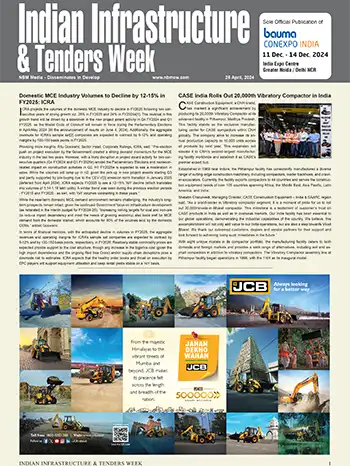Retrofit Strategies for Tilted Multi-Storied RCC Buildings
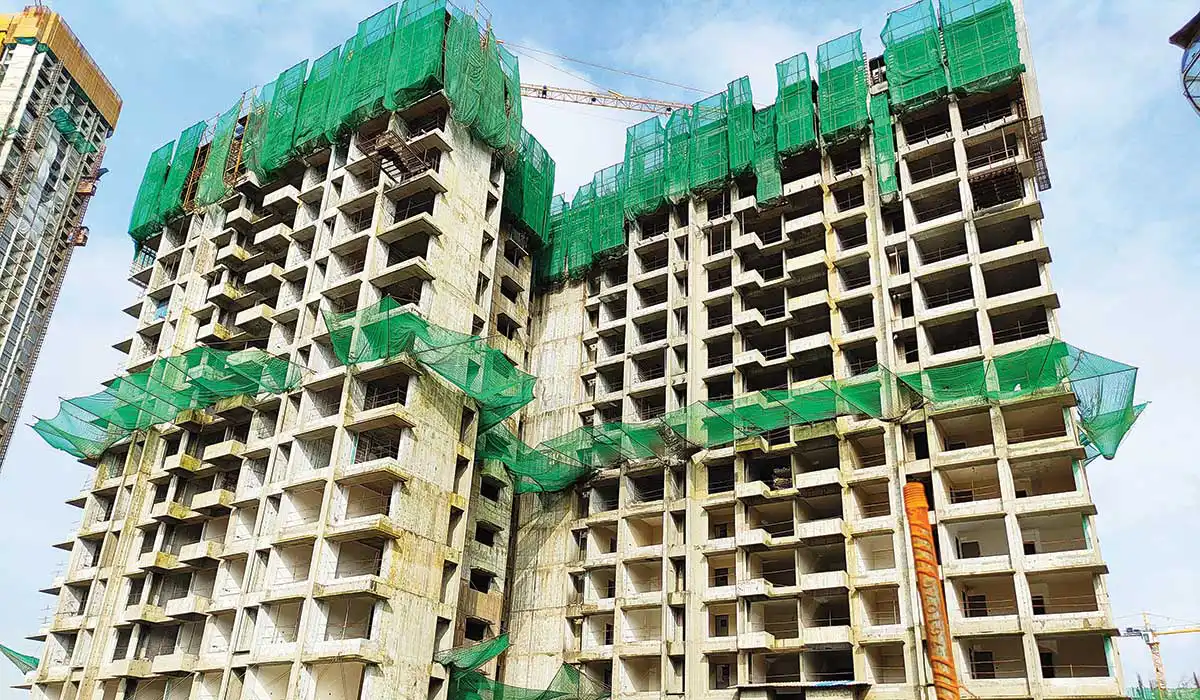
Differential settlement and subsequent tilt of mid-rise RCC buildings structures over alluvial soil of Greater Kolkata and Gangetic Flood Basin have become an issue of concern, as it significantly impacts the overall stability of these buildings, mainly against seismic excitations. Nowadays, various Non-Destructive Tests (NDTs) and verticality assessments of the tilted buildings have become a common practice; but these provide local and piecemeal results; and thus, don’t say much about the global structural stability against seismic vulnerability.
Hence, a detailed seismic vulnerability analysis of the tilted RCC buildings over different soil types with varying structural configurations and degrees of tilt is crucial for assessing safety, further usefulness and repair-feasibility. The present paper uses non-linear static analysis of numerical models of the considered tilted buildings in Finite Element (FE) platform to evaluate the effect of tilt on the seismic vulnerability of these structures. The vulnerability index is used as a parameter for quantifying damage or assessing the effectiveness of repairs in a structure. Three different retrofit strategies are proposed in this study to rectify the adverse effect of tilt, based on vulnerability index approach. Seismic vulnerability index of the tilted structures before and after different retrofit schemes is evaluated based on the Non Linear Push Over Analysis results.
The study reveals that factors like extent of tilt and structural configurations significantly influence the seismic vulnerability of the tilted buildings. Among three retrofit strategies, providing steel bracing is found to be the best retrofit scheme against seismic vulnerability. The current research seems to have its practical applications for assessing seismic vulnerability and optimising different retrofit strategies for existing multi-storied tilted RCC buildings over alluvial soil.
Introduction
Developing areas of Greater Kolkata [22] has shown rapid urbanization and the demand for middle-income group people have led to construction of G+4 storied buildings. The structures are often situated on compacted soil above marshy lands, having irregular soil characteristics. Tidal fluctuations [11] along the Hooghly river is observed, and a greater portion of this area falls within seismic zone IV [17], having a higher risk of liquefaction of underground soil. Consequently, the mid-rise G+4 RCC buildings over shallow isolated footings are prone to differential settlement and subsequent tilt (Figure 1 (a)), mainly during the monsoon. Excavation of nearby plots without proper lateral support [10], deficiencies in design & construction practices, and excessive loads [1-8], are considered to be the main factors responsible for the tilt. The degree and type of tilt significantly affects the structural responses during seismic events and controls the extent of damage. Thus, a thorough numerical investigation into the seismic vulnerability of RCC buildings subjected to various tilts seems to be essential. Non- Destructive Tests give qualitative & piecewise results, making it a challenge to understand the global behavior of the structures. Hence, seismic vulnerability study seems to be essential to assess the structural risks and further their mitigation through development of different retrofit schemes for those affected structures.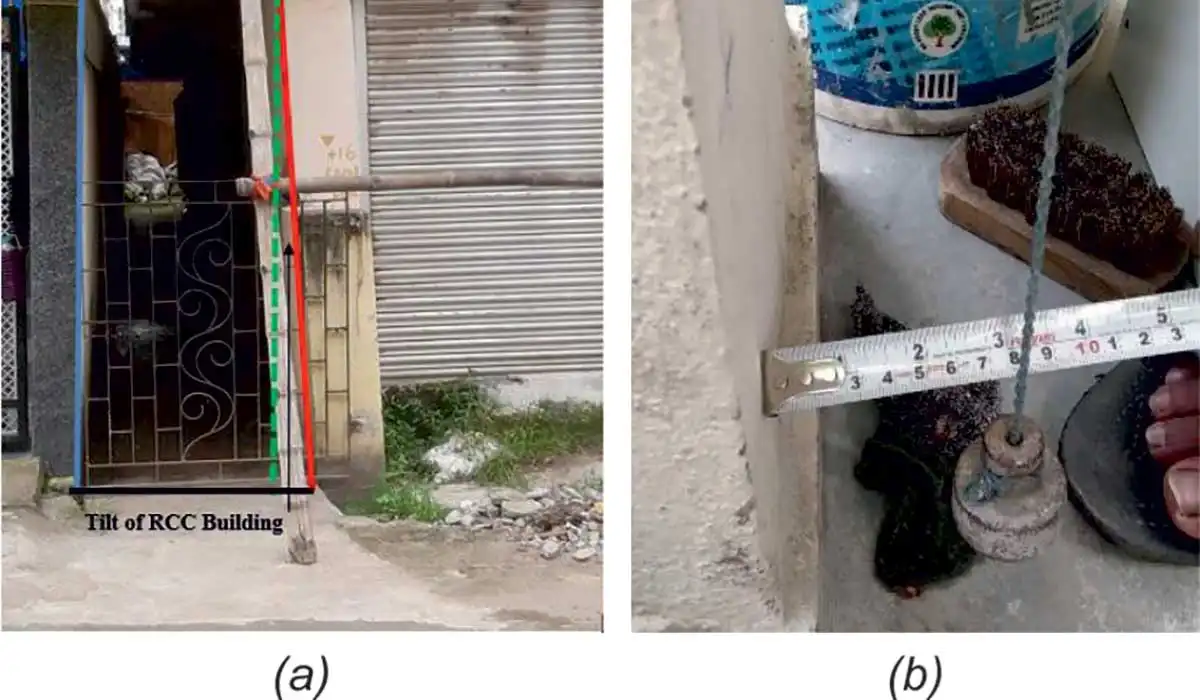 Figure 1: (a) Real-Life Tilted RCC Building, (b) Measurement of Tilt
Figure 1: (a) Real-Life Tilted RCC Building, (b) Measurement of TiltThis present paper aims to assess the seismic vulnerability of G+4 storied RCC residential buildings subjected to tilt, using the results of non-linear static pushover analysis performed in Finite Element platform of SAP2000. A parametric study duly considers various factors like extent & types of tilts, structural configurations, soil type and different retrofit schemes. The research focuses to evaluate the vulnerability indices [20] of these tilted residential buildings before and after retrofit through three proposed retrofit schemes. The lowered vulnerability index after a certain retrofit indicates about betterment of the structural behavior of the tilted RCC building structures. This research seems to have its practical significance to check the seismic vulnerability and repair feasibility of the real-life tilted RCC building structures.
Non Linear Push Over Analysis (NLPOA)
The unpredictable nature of earthquakes requires periodic revisions of seismic design codes, leading to increased seismic demands on existing structures. Structural distress & difficulties in repair pose challenges to achieve required performance levels, even in lighter earthquakes. From a repair standpoint, even minor seismic activities can induce inelastic deformations that may turn a structure irreparable or might make repairs impractical from financial point of view. Retrofitting, while beneficial, may not guarantee overall safety. Hence, a performance-based assessment that focuses on a structure's actual behavior during earthquakes is crucial for ensuring safety. This emphasizes the evolving of dynamic nature of seismic design and assessment.Pushover analysis, as outlined in ATC-55 (Volume 1): 2005 [9] and FEMA 440: 2005 [12], is a crucial non-linear static method to evaluate the seismic performance of a structure. This method incrementally increases lateral loads along the height of the structure to identify the failure modes and weaknesses, if any. The process continues until it identifies a collapse mechanism, and, in turn, the pushover curve (Figure 2 a) provides a clear view on the top displacement with incremental base shear.
 Figure 2: (a) Bi-linearization of Pushover curve, (b) Typical capacity & demand spectrum, and (c) Idealized load-deformation curve for a hinge
Figure 2: (a) Bi-linearization of Pushover curve, (b) Typical capacity & demand spectrum, and (c) Idealized load-deformation curve for a hingePerformance Levels of Structural Elements
Different discrete damage states between point of initial yielding and structural collapse are: Immediate Occupancy (IO), Life Safety (LS), Collapse Prevention (CP); as given in (Figure 2 c). The top drift according to various standards are presented in Table 1. Table 1: Different performance levels including their definitions as per different standards
Table 1: Different performance levels including their definitions as per different standardsFinite Element Modelling
The objective of this present research is to numerically assess the seismic vulnerability of real-life tilted RCC residential buildings in the FE platform of SAP2000 (21.2.0). Each of the FE models of the RCC structures have a plan area of 150 m² (10 m X 15 m) and a height of 17.1 m, as per the dimensions shown in Figure 3. Each FE model of structural systems with 2-bay frames has 126 nodes, 270 frame & 50 shell elements; and each FE model of structural systems with 3-bay frames has 166 nodes, 372 frame & 75 shell elements.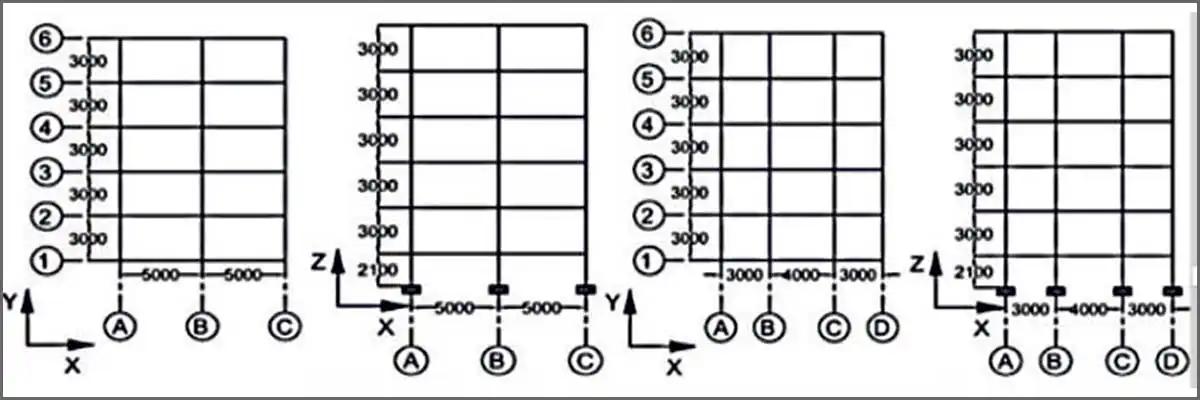 Figure 3: Plan & Elevation of the RCC building structures with 2-bay and 3-bay frame systems
Figure 3: Plan & Elevation of the RCC building structures with 2-bay and 3-bay frame systemsMaterial Properties
In the numerical models, the RCC structural members are considered to have the grade of concrete as M25, with a characteristic strength of 25 MPa. Grade of steel reinforcement is taken as Fe500, with a minimum tensile strength of 545 MPa and a minimum yield strength of 500 MPa. Figure 4: Stress-Strain Curve for (a) M 25 grade of Concrete and (b) Fe 500D grade of Steel
Figure 4: Stress-Strain Curve for (a) M 25 grade of Concrete and (b) Fe 500D grade of SteelSection Details
RCC roof & floor slabs are considered as shell thin elements of thickness 100 mm; and the RCC frame properties are given in Table 2. Table 2: Material specifications of RCC structural Frame members
Table 2: Material specifications of RCC structural Frame membersLoads Considered
Considered loads for analysis of the numerical models using various IS codes are given in Table 3 to 5. Table 3. Gravity Loads Considered in FE Models [14-15]
Table 3. Gravity Loads Considered in FE Models [14-15]Type & Degree of Tilt Considered
In real-life situations, tilt might occur as two types in the existing buildings namely: Uniaxial (along the X- direction) and Biaxial (along both the X and Y-directions) tilt. Hence, both the types of tilts have been duly considered in different FE models. At first, tilt is introduced with a magnitude of 50 mm at the roof level. Further, 50 mm additional increments are applied, finally increasing the tilt up to a maximum of 250 mm. The deformation due to tilt is considered as a rigid body movement in each case. The deformation of other nodal points at different floor levels are then evaluated using linear interpolation. Table 4: Design Wind Load Calculation as per IS 875 (Part 3): 2015 [16]
Table 4: Design Wind Load Calculation as per IS 875 (Part 3): 2015 [16]Soil-Foundation-Structure Interaction Considered in FE Modelling
The FE models are analyzed while considering soil structure interaction (SSI) for analyzing the efficiency of retrofit scheme III over different types of soil. The initial model considers isolated footings under the columns of the tilted buildings, which are further proposed to form strip footings as a part of the retrofit scheme III.By modelling different types of soil and RCC footings in the FE framework of SAP2000 using 3-D solid elements; the soil-foundation-structure interaction is considered in the analysis.
 Table 5. Seismic Load Parameters Considered as per IS 1893 (Part 1): 2016 [17]
Table 5. Seismic Load Parameters Considered as per IS 1893 (Part 1): 2016 [17]Consideration of Different Types of Nonlinearities During Pushover Analysis
Nonlinear static pushover analysis incorporates both the geometric & material nonlinearity. Geometric nonlinearity addresses structural changes resulting from substantial deflections, challenging the adequacy of linear elastic theory.Material nonlinearity takes into account plastic deformation in structural members, modeling the plastic moment- plastic rotation behavior at discrete hinges within the members. These hinges represent points where material yielding induces plastic deformation and are crucial for capturing the structure's behavior under loading conditions that lead to plastic deformations. By considering these nonlinearities, the analysis provides a more accurate representation of a structure's response to different forces and deformations.
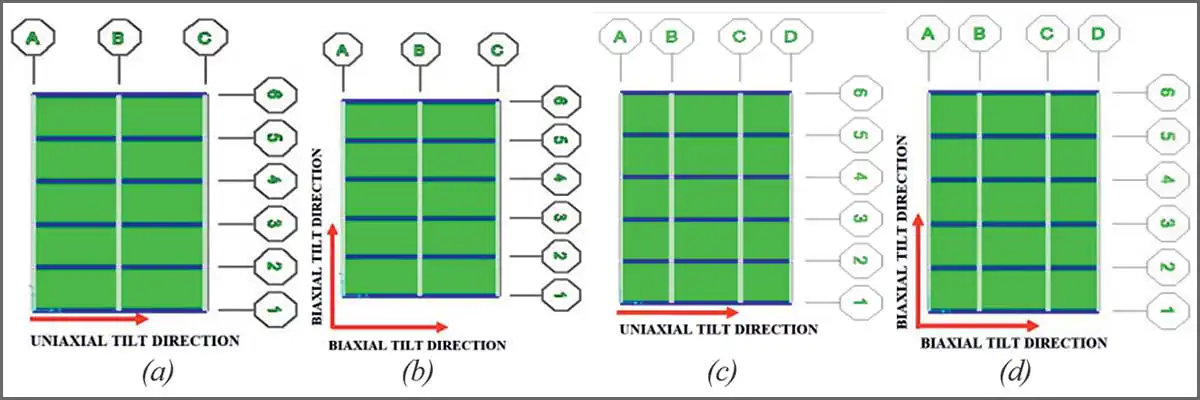 Figure 5 : (a)-(d) Various types of tilt on buildings with different structural arrangement
Figure 5 : (a)-(d) Various types of tilt on buildings with different structural arrangementHinges Considered During Pushover Analysis
In the numerical models, material inelasticity is considered by introducing lumped plasticity at anticipated plastic hinge locations within the frame members. The nonlinear behavior of the beams is simulated using flexural (M3) hinges, while for the columns, the nonlinear behavior is replicated by employing axial force-biaxial moment (P-M2-M3) interaction hinges. These hinges are strategically placed to capture the distinct modes of inelastic behavior expected in the structural members, enabling a more precise representation of the structure's response under different loading conditions.Different Retrofit Schemes Applied to The Numerical Models
Three different types of retrofit schemes are proposed in the current paper to check the efficiency in terms of seismic vulnerability index. These retrofit schemes are described below in details.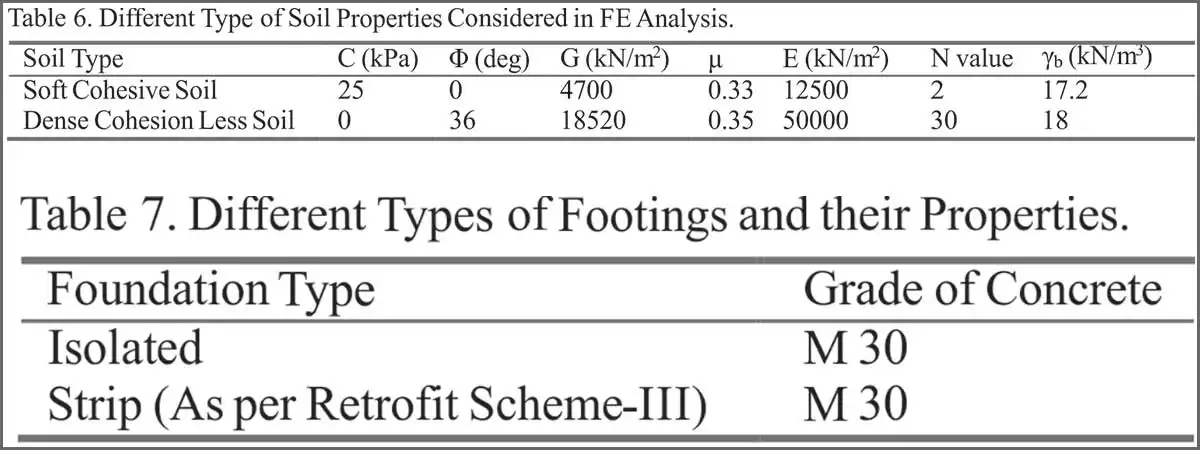 By modelling different types of soil and RCC footings in the FE framework of SAP2000 using 3-D solid elements; the soil-foundation-structure interaction is considered in the analysis.
By modelling different types of soil and RCC footings in the FE framework of SAP2000 using 3-D solid elements; the soil-foundation-structure interaction is considered in the analysis.Retrofit Scheme-I
This scheme proposes a definite higher value of superimposed dead load (SIDL) to be applied at the roof level of the considered RCC frame buildings (fixed base models are considered here); as would counteract some of the 2nd order bending moments due to tilt. The load to be applied along with its intensity is given in Table 8; the preferred locations are shown in Figure 6.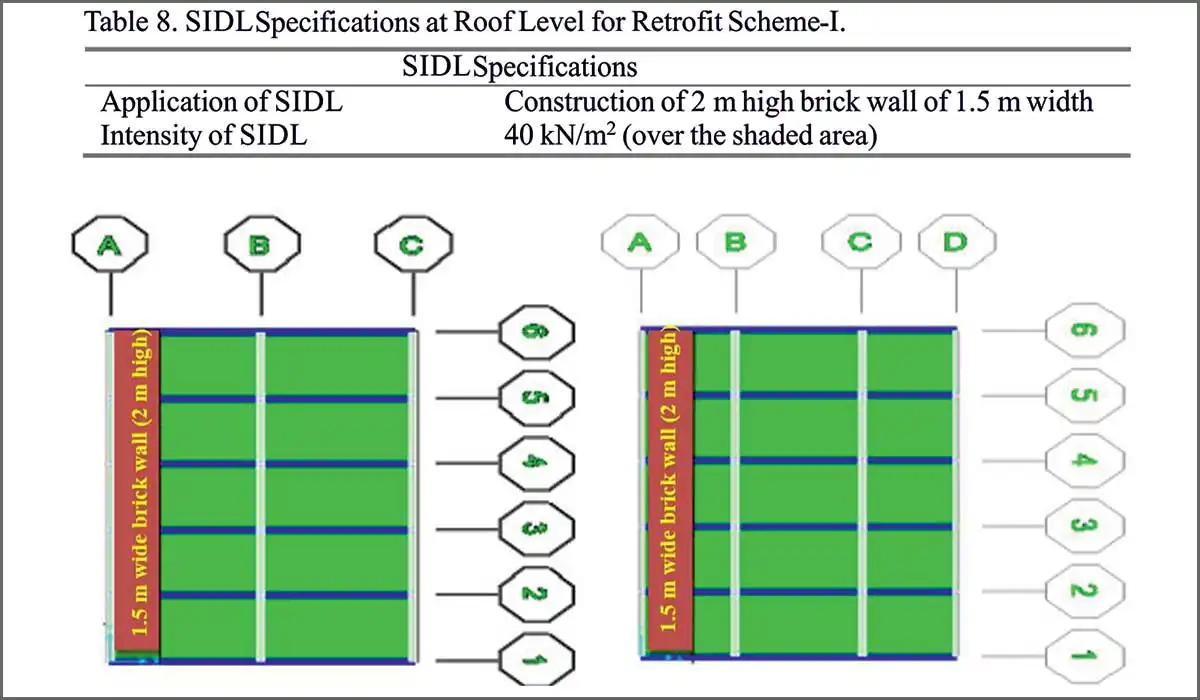 Figure 6: Considered locations for SIDL application at roof level of 2 & 3 bay models as per Retrofit Scheme-I
Figure 6: Considered locations for SIDL application at roof level of 2 & 3 bay models as per Retrofit Scheme-IRetrofit Scheme-II
This scheme proposes to provide steel bracings (fixed base models are considered here) as these act to reduce the shear force and bending moment in the columns of the considered building structures and the lateral seismic load on the structures get transferred to the foundations by the means of axial action. The specifications of the bracings in terms of their sectional details etc. are given in Table 9; the preferred arrangements are shown in Figure 7.For grid 1 and grid 6, the bracings should be provided as per Figure 7; for other grids (i.e. 2 to 5) the bracings would be provided up to first floor level and the arrangement would be as per the Figure 7.

Retrofit Scheme-III
This scheme proposes to connect the isolated footings to form strip footings (shown in Figure 10). The edge columns in the direction of tilt are proposed to be jacketed up to first floor level. The properties of the jacket concrete and new reinforcement to be provided are given in Table 10. Typical jacketing details and the columns to be jacketed are shown in Figure 8 & Figure 9, respectively.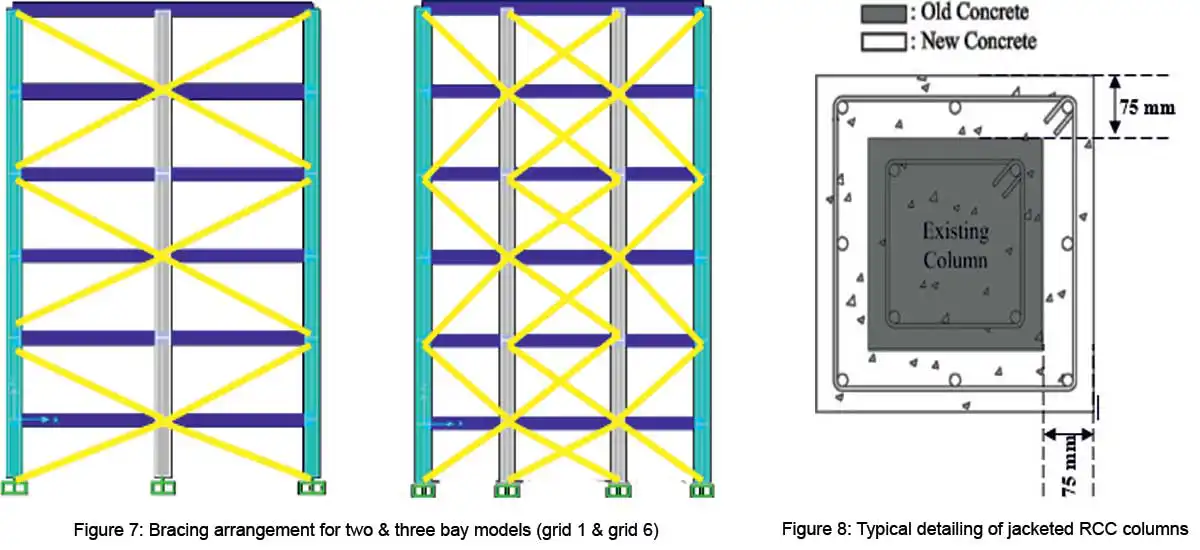
Results And Discussions
Efficiency of different retrofit schemes applied to the tilted RCC residential buildings is assessed through Vulnerability Index evaluated using non-linear static analysis results obtained from FE platform of SAP2000. These results are compared to study the overall efficiency of different Retrofit Schemes proposed for tilted RCC buildings.Vulnerability Index
The vulnerability index [20] may be selected as a parameter to quantify damage, and repair effectiveness in a structure using the results obtained from nonlinear pushover analysis. Here, non-linear push may be taken as the excitation force due to earthquake, and the damage is considered as formation of plastic hinges having different performance levels. Detailed formulae and calculation steps are shown in previous research articles [1, 20].
Various retrofit schemes have led to an overall reduction in the vulnerability index of the analyzed RCC building structures across all numerical models. These schemes demonstrate greater effectiveness in addressing uniaxial tilt, regardless of the number of bays in the structural systems. Between the first two schemes, the second one (i.e., bracing system) proves to be significantly more effective than the first scheme for buildings experiencing any type of tilt. The efficacy of the retrofit schemes is notably higher for three-bay structural models. Consequently, the performance during a seismic event and the feasibility of repair after an earthquake are enhanced for three-bay models.
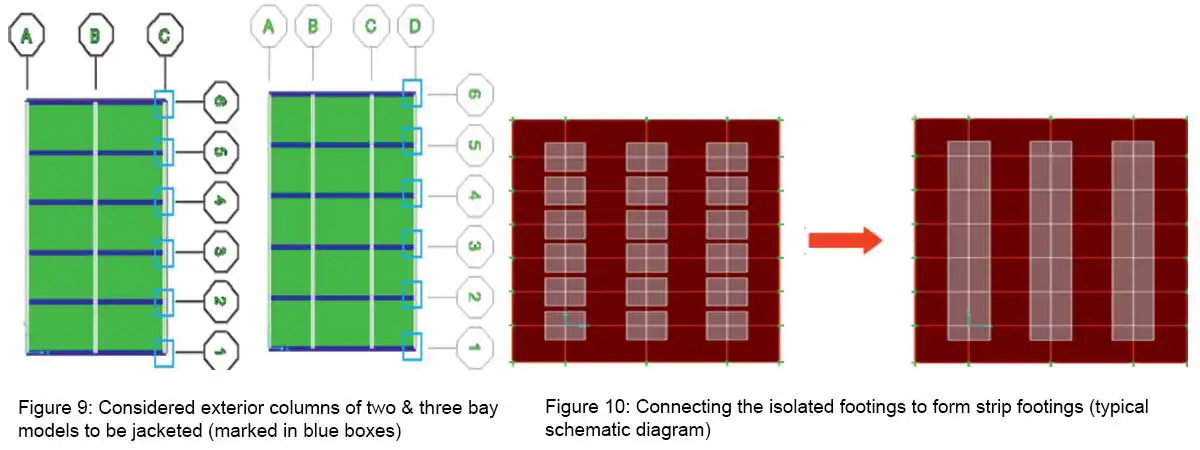
The retrofit of tilted buildings according to Scheme-III has resulted in a decrease in the vulnerability index for all the considered structural models. The significant reduction in the vulnerability index due to this retrofit scheme indicates improved performance of the retrofitted buildings compared to their initially tilted counterparts. This scheme is also observed to be more effective for uniaxial tilt, regardless of the number of bays in the structural systems and the type of soil on which the buildings are situated. The retrofit scheme demonstrates enhanced effectiveness for buildings situated over dense sand, as evident from the provided graphs, irrespective of the type and extent of tilt. The efficiency of the retrofit scheme is notably better for three-bay models.
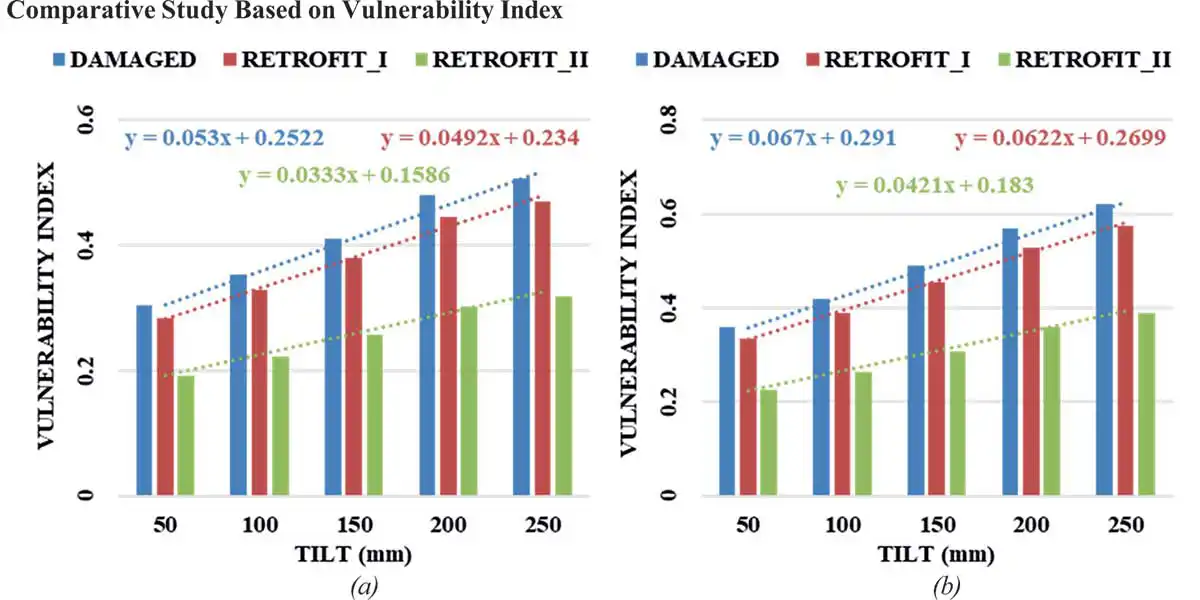 Figure 11 : Comparison of vulnerability indices of 2 bay frame models against different retrofit schemes with incremental (a) uniaxial tilt, (b) biaxial tilt
Figure 11 : Comparison of vulnerability indices of 2 bay frame models against different retrofit schemes with incremental (a) uniaxial tilt, (b) biaxial tiltDifferent retrofit schemes significantly decrease the vulnerability indices due to the formation of less critical hinges in the columns of the buildings, resulting in better hinge conditions and decreased earthquake vulnerability.
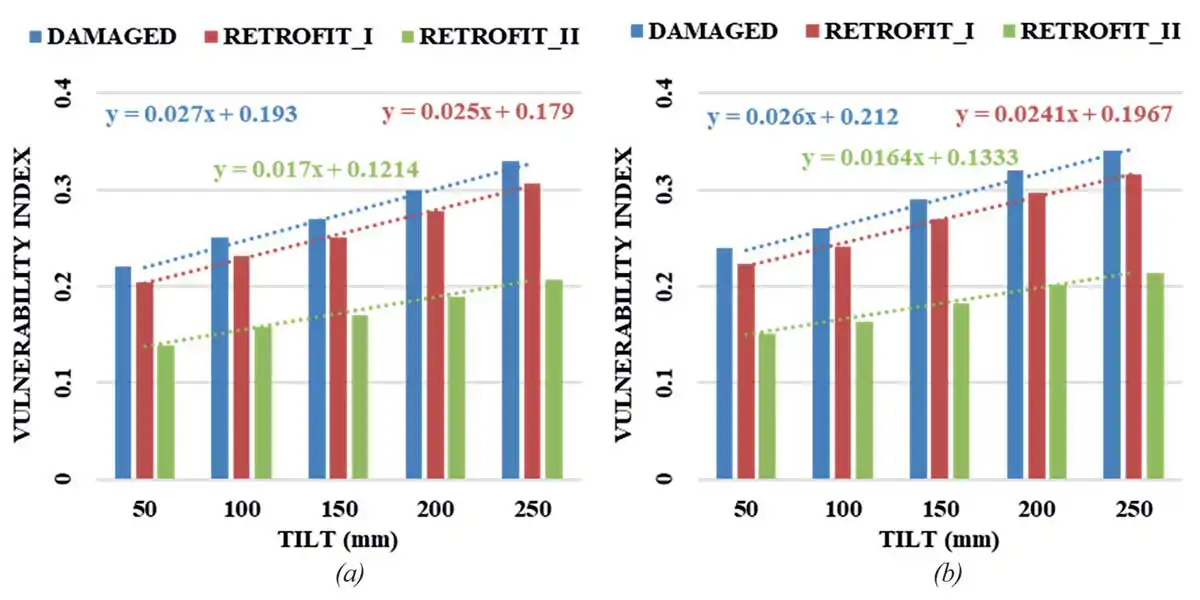 Figure 12 : Comparison of vulnerability indices of 3 bay frame models against different retrofit schemes with incremental (a) uniaxial tilt, (b) biaxial tilt
Figure 12 : Comparison of vulnerability indices of 3 bay frame models against different retrofit schemes with incremental (a) uniaxial tilt, (b) biaxial tiltConclusion
The present paper conducts a comprehensive comparison of the results from nonlinear static analysis of numerical models representing tilted RCC buildings over alluvial soil. This comparative analysis aims to thoroughly assess the effectiveness of various retrofit strategies by examining the vulnerability indices of these structures. The findings provide valuable insights and conclusions regarding the retrofitting approaches employed; and are as follows:- Tilt significantly influences the seismic vulnerability of multi-storied RCC buildings experiencing tilt.
- The vulnerability index shows a notable increase with incremental tilt. The rate of increase is more pronounced for two-bay frame models when compared to that of three-bay frame models.
- Higher vulnerability index is observed for buildings with biaxial tilt than that of the buildings having uniaxial tilt; suggesting about higher seismic vulnerability of the structures subjected to biaxial tilt.
- Three different retrofitting schemes have been proposed; and are duly considered in the finite element modelling.
- The introduction of bracing systems is found to be as the best retrofit scheme for tilted buildings amongst the proposed ones.
- Jacketing of the columns over isolated footings situated in the direction of tilt along with joining those footings to make strips is found to be another good retrofitting scheme for foundations over dense sandy soil as well as soft clayey soil.
- Another retrofitting scheme, in which it was proposed to apply load at roof level in the opposite direction of tilt; was found to be insignificant for betterment of the tilted buildings, when performance based approach is applied.
- The lower vulnerability index as observed in three-bay frame models subjected to uniaxial tilt suggests about their reduced susceptibility to seismic damage. This, in turn, implies better outcomes after seismic retrofitting, as needed.
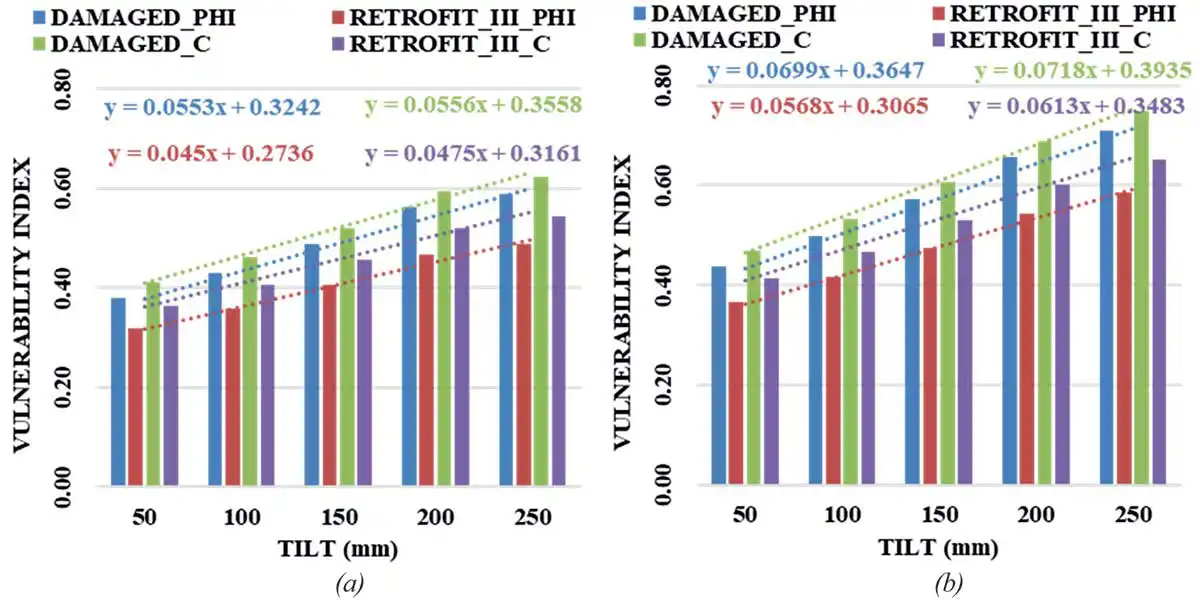 Figure 13 : Comparison of vulnerability indices of 2 bay frame models after retrofit (as per scheme-III) subjected to incremental (a) uniaxial tilt, (b) biaxial tilt
Figure 13 : Comparison of vulnerability indices of 2 bay frame models after retrofit (as per scheme-III) subjected to incremental (a) uniaxial tilt, (b) biaxial tiltThe study's findings hold practical significance, providing a roadmap for protecting the existing real life tilted mid-rise RCC building structures against seismic vulnerability; and guiding about the development of effective repair strategies.
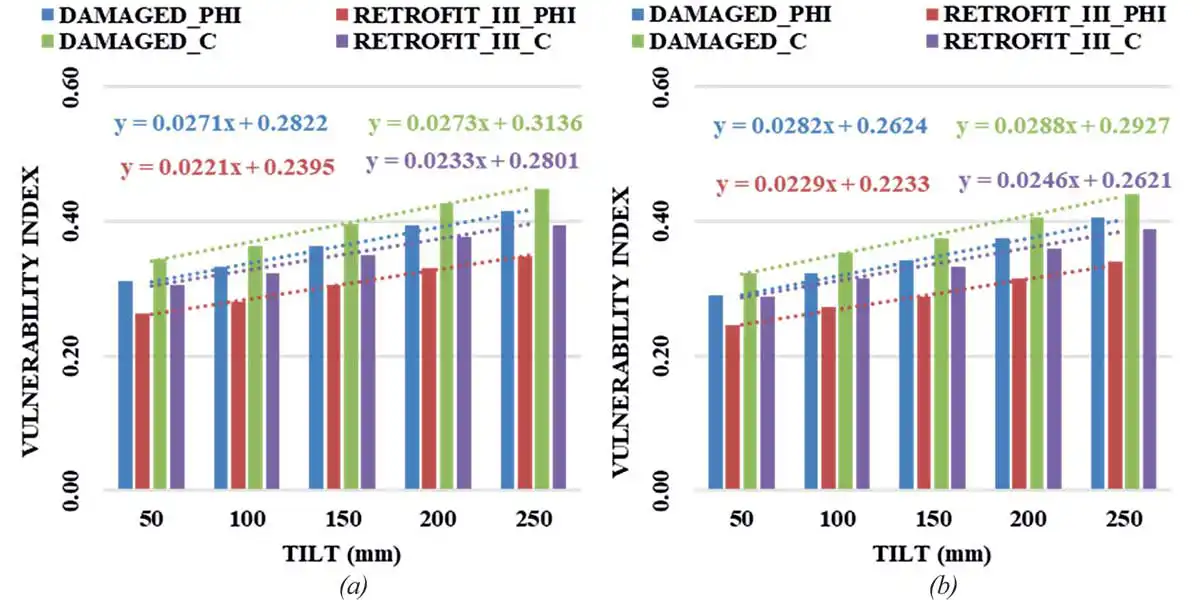 Figure 14 : Comparison of vulnerability indices of 3 bay frame models after retrofit (as per scheme-III) subjected to incremental (a) uniaxial tilt, (b) biaxial tilt
Figure 14 : Comparison of vulnerability indices of 3 bay frame models after retrofit (as per scheme-III) subjected to incremental (a) uniaxial tilt, (b) biaxial tiltReferences
- D. Acharjee (2023). “Stability Analysis of Tilted Multi-Storeyed RCC Buildings over Alluvial Soil: A Non-linear Static Approach”. Materials Today: Proceedings. https://doi.org/10.1016/j matpr.2023.03.627.
- D. Acharjee, S. Bandyopadhyay, D. Bandyopadhyay (2022). “Stability Analysis of a Real Life Tilted RCC Over Head Reservoir (Tank) considering Soil-Structure and Fluid-Structure Interaction”. ASPS Conference Proceedings: Algeria. https://doi.org/10.38208/acp.v1.676.
- D. Acharjee, D. J. Basu, D. Sing, D. Bandyopadhyay (2022). “Stability Assessment of Tilted G+4 RCC Buildings Located at Different Seismic Zones: A Parametric Study”. AIP Conference Proceedings, 2426: 020025. https://doi.org/10.1063/5.0111644.
- D. Acharjee, S. Bandyopadhyay, D. Bandyopadhyay (2022). “Numerical Study of Tilted Multi-Storied RCC Buildings on Shallow Foundations Considering Soil-Structure Interaction”. Aerospace and Associated Technology. 1st ed. CRC Press: London. http://dx.doi.org/10.1201/9781003324539-51.
- D. Acharjee, D. Bandyopadhyay (2021). “Effect of Soil-Structure Interaction on the Stability of Tilted RCC Buildings: A Parametric Study”. Proceedings of National Conference on Innovations & Recent Trends in Civil Engineering. 1st ed. Department of Civil Engineering, SVCE.
- D. Acharjee (2021). “Effect of Tilt & Damage on the Stability of RCC Structures: A Parametric Study”. M.E. Thesis, Jadavpur: Jadavpur University.
- D. Acharjee, D. Sing, D. Bandyopadhyay (2021). “Numerical Study on Effect of Seismic Load on the Stability of Tilted RCC Building”. Proceedings of SITCE, 167-173.
- D. Acharjee, S. B. Choudhury, S. Acharyya, D. Bandyopadhyay (2019). “Parametric Study of Tilt on the Stability of RCC Building”. 7th ICCMS, IIT Mandi.
- ATC-55: (Volume 1) (2005). “Evaluation and Improvement of Inelastic Seismic Analysis Procedures, Third Revision”. Applied Technology Council, California.
- M.S. Aswathy, A. Mittal, S. Behera (2018). “Effect of Excavation on the Settlement of Adjacent Structures, Construction in Geotechnical Engineering”. Proceedings of IGC 2018, 713-722.
- D. Das, B.C. Chattopadhyay (2009). “Characterization of Soil over Kolkata Municipal Area”. IGC 2009, Guntur, INDIA, 11-14.
- FEMA 440 (2005). “Improvement of Nonlinear Static Seismic Analysis Procedures”. Federal Emergency Management Agency, Washington, D.C.
- IS 456 (2000). “Plain and Reinforced Concrete - Code of Practice”. Fourth Revision. BIS.
- IS 875 (Part 1) (1987). “Code of Practice for Design Loads (Other than Earthquake) For Buildings and Structures. Part 1: Dead Loads-Unit Weights of Building Materials and Stored Materials”. Second Revision. BIS.
- IS 875 (Part 2) (1987). “Code of Practice for Design Loads (Other than Earthquake) For Buildings and Structures. Part 2: Imposed Loads”. Second Revision. BIS.
- IS 875 (Part 3) (2015). “Code of Practice for Design Loads (Other than Earthquake) For Buildings and Structures. Part 3: Wind Loads”. Third Revision. BIS.
- IS 1893 (Part 1) (2016). “Criteria for Earthquake Resistance design of Structures, Part-I: General provision and buildings”. Sixth Revision. BIS.
- IS 516 (Part 5: Sec 1) (2018). “Hardened Concrete —Methods of Test Part 5 Non-destructive Testing of Concrete Section 1 Ultrasonic Pulse Velocity Testing”. First Revision. BIS.
- IS 516 (Part 5: Sec 4) (2020). “Hardened Concrete-Methods of Test - Part 5 Non-Destructive Testing of Concrete - Section 4 Rebound Hammer Test”. First Revision. BIS.
- N. Lakshmanan (2006). “Seismic Evaluation and Retrofitting of buildings and Structures”. ISET Journal of Earthquake Technology, Paper No. 469, 26th ISET Annual Lecture.
- SAP 2000 v 21.2.0. “Integrated Software for Structural Analysis and Design, Computers and Structures, Inc. Structural and Earthquake Engineering Software”.
- U. Sengupta, A. Tipple (2007). “The Performance of Public-sector Housing in Kolkata, India, in the Post-Reform Milieu”. Urban Studies.
ICCT, March - April 2024


















